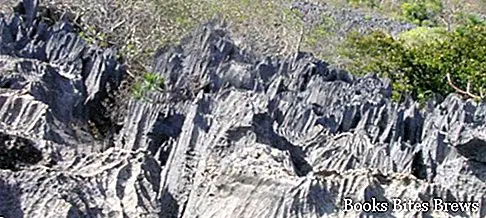The flow of surface waters has changed this steep massif into an inaccessible territory, including an impenetrable scrub and made harsh by sharp rocks, unstable boulders and rocky bastions.
Ankarana National Park
Between North Anivoran and Ambilobe, in northern Madagascar, a vast limestone plateau extends slightly downhill, raised and split by faults to the west, at the Ankarama wall, a rock formation developed from north to south for about 25 kilometers.
The plateau is limited to the east by the Isalo sandstones and to the west by the quaternary basaltic formations of the Amber mountain, which touch the base of the wall.
The end of the escarpment is submerged to the south by the Ambilobe delta.
This block, formed by limestone in the upper part, was subjected to strong tectonic thrusts at the time of the formation of the Amber mountain, its height does not exceed 300 meters.
Weathered, it is characterized by limestone rock formations having the spire aspect, a development rarely found in other areas of the world, indicated by the term Tsingy.
With an average height of about 250 meters, this wall is affected by the flow of surface waters, which over time have dug deep grooves and created stalactites resting on the shelves.
The deep waters gush out at the foot of the escarpment, creating various caves characterized by the portico finely decorated with limestone concretions, such as those of the Mananjeba cave in the south and Elisabeth cave in the north.
To the south the escarpment splits into residual boulders, while in the center the fractured crystalline limestone is divided into ramparts separated by deep corridors, some of tectonic origin, others originating from the collapse of ancient tunnels placed in correspondence with the fracture network.
Each bastion carries numerous sinkholes with steep edges, invaded by shrubs and characterized by a bottom covered with boulders and stones.
On the mass of limestones the sharp shapes of the Tsingy gradually appear, composed of sharp spiers, unstable boulders and smooth surfaces, factors that make it practically impenetrable.
Recommended readings- Andrafiabe: the most beautiful cave in Madagascar
- Nosy Be: what to see on the island off Madagascar
- Madagascar: useful information
- Andringitra: chain and national park of Madagascar
- Ankarana: national park of Madagascar
Such morphology, combined with dense natural vegetation, ensures total protection of Ankarana from any attempt at human penetration.
Only with a helicopter flight is it possible to appreciate in its entirety the spectacular landscape of the karst blades.




